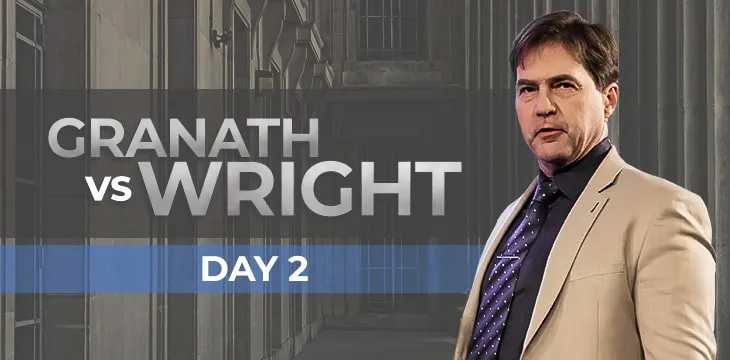|
Getting your Trinity Audio player ready...
|
Following a full day of argument from Magnus Granath’s lawyers, Day 2 of Granath v Wright saw Dr. Craig Wright’s attorney make his opening statements to the Oslo District Court, presenting the core of the defendant’s case.
Halvor Manshaus, attorney from Schjødt and Dr. Wright’s counsel in the case, set the stage by contrasting the defendant, Dr. Wright, with Magnus Granath. Of Granath, he said:
“This person is anonymous, so it’s difficult to hold him accountable. A person is held to their reputation with what they say, but an anonymous person is not. This was an out of the blue, targeted attack.”
“It encourages rabid and increasing toxic attacks to become culturally acceptable.”
Dr. Wright doesn’t need to prove he’s Satoshi Nakamoto to field a defense. Neither does Granath have to prove he isn’t. Whether there is an adequate factual basis for Granath’s tweets is just one factor in determining whether Granath has defamed Wright. The nature of Granath’s attacks and the context in which they were made will also be key factors.
“We aren’t here to determine whether Dr. Wright is a fraud—we are here to see if Granath has defamed Dr Wright,” Manshaus said.
Manshaus also brought attention to the large amount of documents filed by Granath in the case, including right up until trial, and noted that Granath’s case is largely based on the ‘millions’ of pages of documents pilfered from Dr. Wright’s other cases and the ‘poor’ research done by those on social media.
Manshaus refuted Granath’s claim that Dr. Wright revealed himself as Satoshi via a ‘self-leak,’ as Granath’s attorney’s alluded to during their opening statements on Monday. On the contrary, he said, Dr. Wright is someone who has tried very hard to stay private, as the evidence shows. Emails shown during Kleiman v Wright demonstrate this, as Dr. Wright scrambled to decide how to respond to the encroachment of journalists from Gizmodo and Wired. Regarding the 2016 signing demonstrations, Manshaus cited independent journalist Andrew O’Hagan, who reported on the ‘huge strain’ on Dr. Wright—apparent to all present—arising from him feeling compelled to participate in demonstrations which he knew would reveal his long-standing secret concerning his Bitcoin invention.
They also pointed to Gavin Andresen and Jon Matonis, two participants in the 2016 private signing demonstration who were outspoken in their belief that Dr. Wright is Satoshi. The two were mentioned in Granath’s opening remarks, where their belief in Dr. Wright was downplayed, but Manshaus said that both had been convinced on multiple bases: the cryptographic, their personal knowledge of Satoshi and their continued belief in Dr. Wright (on Day of the trial, Granath’s lawyers even quoted from Andresen’s Kleiman deposition, in which he reiterated that he still feels that Dr. Wright is more likely than not Satoshi).
Andresen is particularly important, because unlike Granath, Andresen is better placed than almost anyone to assess whether there is a factual basis for Dr. Wright’s status as Bitcoin’s inventor. Gavin was heavily involved in Bitcoin’s early development, having been handed control by Satoshi upon the latter’s departure, and communicated extensively with Satoshi Nakamoto in private correspondence. And Andresen still believes that Dr Wright is Satoshi—so what leg does Granath have to stand on?
Gavin's response immediately after. Halvor quoting from this video and explaining that it wasn't just the cryptography that proves it for him. He didn't trust the crypto as much as he trusted his personal tests of specific knowledge: https://t.co/qMrJIr9zsc
— Kurt Wuckert Jr | GorillaPool.com (@kurtwuckertjr) September 13, 2022
Manshaus also focused on the tweets of Granath themselves, something which was conspicuously absent from Granath’s own opening. It was the first time the statements at the heart of the case were read aloud in court in their entirety. The words speak for themselves—repeated use of the words ‘scammer’ and ‘fraud,’ and the labelling of Dr. Wright as ‘mentally ill’—but Manshaus also pointed out that many of the tweets were aimed at gaining internet clout, far removed from Granath’s claim that he was engaging in any kind of journalistic exercise. The tweets often contained invitations for others to join in, and encouraged others to use his invented hashtag attacking Dr Wright.
The court was also treated to a behind-the-curtain look at just how organized the attacks on Dr. Wright have been. The impact of Granath’s social media blitz was also brought to the fore. Manshaus read from a log of messages from a Telegram group labeled ‘Bitcoin Plebs,’ where the members coordinate attacks on digital asset projects they dislike, often naming Dr. Wright and BSV specifically.
“Best way to respond to these clowns is to put pressure on exchanges to delist BSV. No liquidity: it dies,” wrote one member.
The members discuss tactics for these attacks, such as being careful not to use language too extreme, while encouraging one another to go after the leaders of these projects, such as Dr. Wright, and their supporters. They also talk about getting the projects delisted from digital asset exchanges—something which worked to great effect. Manshaus was clear that we don’t know if Granath was one of the members of this group, but his hashtag and Twitter campaign featured in the messages—which speaks to the wide influence Granath’s tweets had on the general level of animosity towards Dr Wright.
Craig Wright is not Satoshi.
Anymore of this sh!t, we delist! https://t.co/hrnt3fDACq
— CZ 🔶 BNB (@cz_binance) April 12, 2019
The trial continues Wednesday, September 14, when Magnus Granath and Dr. Wright are expected to take the stand to give their own statements. It will be the first time the court has heard directly from either of them in this trial.
Watch Granath vs Wright Satoshi Norway Trial Coverage Livestream Day 2:

 07-14-2025
07-14-2025 





